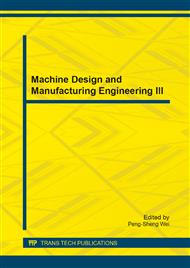[1]
A.E. Karem, Optimum Speed Rotor, U.S. Patent 6, 007, 298. (1998).
Google Scholar
[2]
R.W. Prouty, Should We Consider Variable Rotor Speeds, J. Vertiflite. 50 (2004) 24-27.
Google Scholar
[3]
J. Steiner, F. Gandhi, An Investigation of Variable Speed Rotor RPM on Performance and Trim.
Google Scholar
[4]
D. Han, Study on the Performance and Trim of a Helicopter with a Variable Speed Rotor, J. Acta Aeronauticaet Astronautica Sinica. 34 (2012) 1241-1248.
Google Scholar
[5]
D. Han, E.C. Smith, Lagwise dynamic analysis of a variable speed rotor, J. Aerospace Science and Technology. 29 (2013) 277-286.
DOI: 10.1016/j.ast.2013.03.010
Google Scholar
[6]
J. DiOttavio, D. Friedmann, Operational Benefits of an Optimal Widely Variable Speed Rotor.
Google Scholar
[7]
B. Berry, I, Chopra, Wind Tunnel Testing for Performance and Vibratory Loads of a Variable Speed Mach-scale Rotor [C]/American Helicopter Society 67th Annual Forum. Virginia, 2011: 1227-1240.
Google Scholar
[8]
G.B. Davies, I. Chopra, Aeromechanics of a Variable Speed Rotor [C]/American Helicopter Society 67th Annual Forum. Virginia, 2011: 1058-1073.
Google Scholar
[9]
G. Bir, I. Chopra, University of Maryland Advanced Rotorcraft Code (UMARC) Theory Manual, R. UM-Aero Report. (1992)42-46.
Google Scholar
[10]
M.J. Bhagwat, J.G. Leishman, Stability Analysis of Helicopter Rotor Wakes in Axial Flight, J. Journal of the American Helicopter Society. 45 (2000) 165-178.
DOI: 10.4050/jahs.45.165
Google Scholar
[11]
J.G. Leishman, T.S. Beddoes, A Semi-empirical Model for Dynamic Stall, J. Journal of the American Helicopter Society. 34 (1989) 7-16.
DOI: 10.4050/jahs.34.3.3
Google Scholar
[12]
D.R.J. Owen, E. Hinton, Finite Elements in Plasticity: Theory and Practice, Pineridge Press, Wales, 1980, pp.431-436.
Google Scholar
[13]
R. Kufeld, D.L. Balough, J.L. Cross, and K.F. Studebaker, Flight Testing the UH-60A Airloads Aircraft [C]/The 50th American Helicopter Society, Washington, D.C., 1994: 557.
Google Scholar
[14]
R. Heffernan, M. Gaubert, Structural and Aerodynamic Loads and Performance Measurements of an SA 349/2 Helicopter with an Advanced Geometry Rotor, R. NASA TM-88370. (1986) 1-58.
Google Scholar
[15]
R. Blackwell, T. Millott, Dynamics Design Characteristics of the Sikorsky X2 Technology Demonstrator Aircraft [C]/American Helicopter Society 64th Annual Forum. 2008: 886.
Google Scholar


